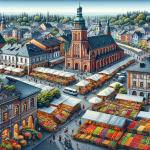
The 19th century was a big deal for Polish art. It was a time when some really important artists came along and changed the game. These artists included Matejko, known for his epic paintings of historical events; Chełmoński, who captured the beauty of the Polish countryside like no one else; Malczewski, who used symbols in his art to tell deeper stories; Grottger, known for his powerful storytelling through art; and Gierymski, who was brilliant at painting landscapes. Together, these artists played a huge role in shaping Poland’s national identity through their art.
Their work reflected the complex times they were living in, including all the social and political ups and downs. But more than that, they set the stage for future artists in Poland, showing them new ways to think about and create art. Let’s take a closer look at what they did and why it still matters to Polish culture today.
The Romantic Rebel: Matejko
Jan Matejko played a key role in Polish Romanticism, a period marked by a strong sense of national identity and the desire for independence. He is best known for his paintings that don’t just show historical events but also express the desire for freedom that was so important at the time. Matejko had a knack for including Polish legends and patriotic messages in his art. This wasn’t just decoration; it was a way of speaking to the hearts of the Polish people, encouraging them to remember their history and to hope for a better future.
Matejko’s painting style is remarkable for its detail and accuracy. He didn’t just paint pictures; he told stories. For example, his painting ‘The Battle of Grunwald’ doesn’t only show the battle itself but also the emotions and the stakes for Poland. This approach made history feel alive and relevant, helping people connect with their past in a deeply personal way.
Moreover, Matejko had a gift for making his paintings speak to the current events of his time. Even though he depicted scenes from the past, his work inspired people who were living under foreign rule, reminding them of their history of resistance and resilience. This wasn’t just art for art’s sake; it was art with a purpose.
In simpler terms, Jan Matejko was more than an artist. He was a storyteller and a patriot. Through his detailed and accurate paintings, he reminded the Polish people of their past and inspired them to dream of independence. His work shows that art can do more than just look beautiful – it can also inspire and motivate.
The National Bard: Chełmoński
Józef Chełmoński stands out in Polish art history for his unique approach to depicting the country’s rural landscapes and the lives of its people. Unlike many of his contemporaries in Europe who pursued more abstract or stylized forms of art, Chełmoński focused on showcasing Poland’s countryside with striking realism and empathy. His paintings are rich in detail and emotion, offering a window into the lives of Polish peasants. This approach not only set him apart but also played a crucial role in highlighting Poland’s national identity through art.
Chełmoński had a knack for using light and shadow in his paintings, which brought the Polish countryside to life on canvas. His technique involved bold brush strokes that captured the rugged beauty of the landscape and the resilience of its people. Through his art, Chełmoński told stories of the struggles and joys experienced by the Polish peasantry, providing insight into a way of life that was both challenging and beautiful. His works serve as a testament to the enduring spirit of Poland and its people, making him a key figure in the country’s cultural revival during the 19th century.
Moreover, Chełmoński’s contribution to Polish art wasn’t just about depicting landscapes and daily life. He played a significant role in fostering a sense of national pride and identity through his paintings. By focusing on the unique aspects of Poland’s rural areas, he helped to create a visual narrative that resonated with the Polish people, reinforcing their connection to the land and their heritage. His art became a powerful tool in the broader movement of Polish nationalism, celebrating the country’s spirit and contributing to its cultural renaissance.
In conversations about Chełmoński’s impact, it’s essential to recognize how his work bridged the gap between art and national identity. His paintings are more than just beautiful scenes of the Polish countryside; they are a celebration of Poland’s spirit and an integral part of the country’s cultural history. For those interested in exploring Chełmoński’s art, visiting museums that feature his work or looking into books and documentaries about his life and contributions would offer a deeper understanding of his significance in Polish art and nationalism.
The Poet of Paint: Malczewski
Jacek Malczewski stands out as a unique voice in the world of 19th-century Polish art. Unlike Józef Chełmoński, who focused on capturing the essence of rural Poland, Malczewski took a different path. He is best known for his symbolist artwork, which dives deep into themes of Polish identity, mythology, and the human condition. His paintings didn’t just depict scenes; they told stories filled with nationalistic and personal themes, all wrapped in layers of symbols.
Malczewski was a master at using allegory and symbolism to explore complex ideas. For example, in his painting ‘Thanatos,’ he combines elements of Greek mythology with Polish folklore to comment on the nature of life and death, showcasing his ability to blend different cultural references to create a unique narrative. This approach made his work stand out for its depth and its ability to provoke thought about deeper existential questions.
He also had a knack for capturing the spirit of his times. Through his paintings, Malczewski addressed the struggles and aspirations of the Polish people, making his work resonate on both a personal and a collective level. His skillful technique and imaginative compositions helped viewers understand the emotional and spiritual currents of his era.
Malczewski’s influence on Polish art cannot be understated. His pioneering work in symbolism opened new avenues for artists who followed, helping to shape the future of Polish art. Today, his legacy is evident in the way he enriched Polish art history with his visionary approach and profound understanding of the human experience. His work serves as a testament to the power of art to explore and express complex ideas and emotions, making him a true ‘Poet of Paint.’
The Visionary: Grottger
Artur Grottger played a significant role in 19th-century Polish art, especially during the Romantic period. He is well-known for his powerful artwork that reflects the Polish fight for independence. His work deeply connects with Poland’s national identity, showing historical events in a way that people everywhere can understand their importance. Grottger had a unique style that mixed dramatic scenes with emotional depth, capturing the intense feelings of a nation facing difficult times.
One of the key aspects of Grottger’s art is how he told stories through his drawings and lithographs. His series ‘Polonia’ and ‘Lituania’ are perfect examples of this. In these works, he didn’t just show events; he used visual storytelling to tackle big social and political issues. This was a new way of doing things at the time and showed that art could be a powerful tool for talking about national identity and fighting for freedom.
Grottger’s artwork stands out because of how he combined narrative with composition. He didn’t just paint pictures; he told stories that made people think and feel deeply about the subjects he depicted. For anyone interested in the power of art to convey complex themes and inspire change, Grottger’s work is a must-see. His ability to evoke strong emotions and provoke thought about the struggle for independence makes his art not just beautiful but also meaningful.
In conversation, talking about Grottger’s work can open up discussions about the role of art in society and how it can influence political and social change. His art serves as a reminder of the struggles for independence and the deep connection between national identity and cultural expression. Through his innovative approach to storytelling and composition, Grottger has left a lasting impact on the world of art and the way we think about the power of visual narratives.
The Landscape Maestro: Gierymski
Moving away from Grottger’s emotional stories, let’s dive into the world of Maksymilian Gierymski, a master of landscape painting in the 19th century in Poland. Gierymski had a unique way of painting landscapes that goes beyond just showing what a place looks like. He captured the heart of the Polish countryside, making his paintings feel alive with a sense of both time and place. This wasn’t just about good painting skills; it was about telling the story of Poland through its landscapes.
Gierymski had an exceptional skill in using light and shadow in his paintings. This technique did more than just make the landscapes look realistic. It brought out the emotions and cultural importance of these places. It’s as if through his paintings, he was saying, ‘Look, this is what it feels like to be in Poland. This is what we’re all about.’ His work is a key part of Polish art because it takes us beyond just seeing a beautiful scene. He invites us to feel and understand the deep connection between the Polish identity and its land.
To really get how special Gierymski’s work is, think about how a photograph can capture a moment in time. Now, imagine that, but with the added layers of emotion, cultural meaning, and a hint of history. That’s what you get with Gierymski’s landscapes. They’re not just pictures on a canvas; they’re invitations to explore the soul of Poland without leaving your room.
His paintings are also a testament to the power of art in exploring and expressing national identity. Through his focus on the Polish countryside, Gierymski not only showcased its beauty but also highlighted its significance to the Polish people. It’s a reminder that landscapes are more than just backdrops; they’re intertwined with who we are and where we come from.
In a nutshell, Maksymilian Gierymski’s contribution to Polish art is monumental. He managed to blend technique, emotion, and cultural storytelling in a way that few artists can. By looking at his paintings, we’re not just seeing the Polish countryside; we’re experiencing a piece of Polish soul. And that’s something truly remarkable.
Conclusion
In the 19th century, Poland had some incredible artists who did more than just create beautiful art. Artists like Matejko, Chełmoński, Malczewski, Grottger, and Gierymski made art that spoke to the heart of what it means to be Polish. They mixed national pride and romantic ideals into their paintings, helping shape how people saw Poland’s culture and history.
Their work wasn’t just for art’s sake; it helped build a sense of Polish identity. Today, their art still touches people and plays a big part in Poland’s cultural and historical pride.






Comments are closed.